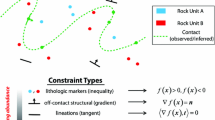Abstract
Due to the complex nature of multi-source geological data, it is difficult to rebuild every geological structure through a single 3D modeling method. The multi-source data interpretation method put forward in this analysis is based on a database-driven pattern and focuses on the discrete and irregular features of geological data. The geological data from a variety of sources covering a range of accuracy, resolution, quantity and quality are classified and integrated according to their reliability and consistency for 3D modeling. The new interpolation-approximation fitting construction algorithm of geological surfaces with the non-uniform rational B-spline (NURBS) technique is then presented. The NURBS technique can retain the balance among the requirements for accuracy, surface continuity and data storage of geological structures. Finally, four alternative 3D modeling approaches are demonstrated with reference to some examples, which are selected according to the data quantity and accuracy specification. The proposed approaches offer flexible modeling patterns for different practical engineering demands.
Similar content being viewed by others
References
Breunig M. An approach to the integration of spatial data and systems for a 3D geo-information system[J]. Computers & Geosciences, 1999, 25(1): 39–48.
Sirakov N M, Granado I, Muge F H. Interpolation approach for 3D smooth reconstruction of subsurface objects[ J]. Computers & Geosciences, 2002, 28(8): 877–885.
Lemon A M, Jones N L. Building solid models from boreholes and user-defined cross-sections[J]. Computers & Geosciences, 2003, 29(5): 547–555.
Sprague K, de Kemp E A. Interpretive tools for 3-D structural geological modelling. Part II: Surface design from sparse spatial data[J]. GeoInformatica, 2005, 9(1): 5–32.
Brandel S, Schneider S, Perrin M et al. Automatic building of structured geological models[J]. Journal of Computing and Information Science in Engineering-ASME, 2005, 5(2): 138–148.
Hack R, Orlic B, Ozmutlu S et al. Three and more dimensional modelling in geo-engineering[J]. Bull Eng Geol Environ, 2006, 65: 143–153.
Zhong D H, Li M C, Song L G et al. Enhanced NURBS modeling and visualization for large 3D geoengineering applications: An example from the Jinping first-level hydropower engineering project, China[J]. Computers & Geosciences, 2006, 32(9): 1270–1282.
Tonini A, Guastaldi E, Massa G et al. 3D geo-mapping based on surface data for preliminary study of underground works: A case study in Val Topina (Central Italy)[J]. Engineering Geology, 2008, 99(1/2): 61–69.
Turanboy A, Gokay M K, Ulker E. An approach to geometrical modelling of slope curves and discontinuities[J]. Simulation Modelling Practice and Theory, 2008, 16(4): 445–461.
Royse K R, Rutter H K, Entwisle D C. Property attribution of 3D geological models in the Thames Gateway, London: New ways of visualising geoscientific information[J]. Bull Eng Geol Environ, 2009, 68: 1–16.
Wang B J, Shi B, Song Z. A simple approach to 3D geological modelling and visualization[J]. Bull Eng Geol Environ, 2009, 68: 559–565.
Xu Nengxiong, Tian Hong. Wireframe: A reliable approach to build sealed engineering geological models[J]. Computers & Geosciences, 2009, 35(8): 1582–1591.
Zhang L Q, Tan Y M, Kang Z Z et al. A methodology for 3D modeling and visualization of geological objects[J]. Science in China Series D - Earth Sciences, 2009, 52(7): 1022–1029.
Ming J, Pan M, Qu H G et al. GSIS: A 3D geological multi-body modeling system from netty cross-sections with topology[J]. Computers & Geosciences, 2010, 36(6): 756–767.
Bianchi Fasani G, Bozzano F, Cercato M. The underground cavity network of south-eastern Rome (Italy): An evolutionary geological model oriented to hazard assessment[J]. Bull Eng Geol Environ, 2011, 70: 533–542.
Caumon G. Towards stochastic time-varying geological modeling[J]. Mathematical Geosciences, 2010, 42(5): 555–569.
Piegl L, Tiller W. Algorithm for approximate NURBS skinning[J]. Computer-Aided Design, 1996, 28(9): 699–706.
Shi F Z. Computer-Aided Geometry Design and Non- Uniform Rational B-Spline (CAGD & NURBS)[M]. Higher Education Press, Beijing, China, 2001. 288.
Li Z L, Zhu Q. Digital Elevation Model[M]. Wuhan Technical University of Surveying and Mapping Press, Wuhan, China, 2000 (in Chinese)
Author information
Authors and Affiliations
Corresponding author
Additional information
Supported by the National Natural Science Foundation of China (No. 51379006 and No. 51009106), the Program for New Century Excellent Talents in University of Ministry of Education of China (No. NCET-12-0404), and the National Basic Research Program of China (“973” Program, No. 2013CB035903).
Rights and permissions
About this article
Cite this article
Li, M., Han, Y., Miao, Z. et al. Alternative 3D modeling approaches based on complex multi-source geological data interpretation. Trans. Tianjin Univ. 20, 7–14 (2014). https://doi.org/10.1007/s12209-014-2171-4
Accepted:
Published:
Issue Date:
DOI: https://doi.org/10.1007/s12209-014-2171-4




